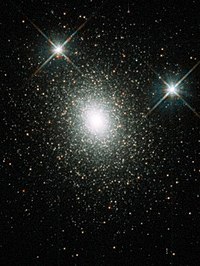
Photo from wikipedia
Primordial black holes possibly formed in the early Universe could provide a significant fraction of the dark matter and would be unique probes of inflation. A smoking gun for their… Click to show full abstract
Primordial black holes possibly formed in the early Universe could provide a significant fraction of the dark matter and would be unique probes of inflation. A smoking gun for their discovery would be the detection of a subsolar mass compact object. We argue that extreme mass-ratio inspirals will be ideal to search for subsolar-mass black holes not only with LISA but also with third-generation ground-based detectors such as Cosmic Explorer and the Einstein Telescope. These sources can provide unparalleled measurements of the mass of the secondary object at a subpercent level for primordial black holes as light as O(0.01) M_{⊙} up to luminosity distances around hundred megaparsec and few gigaparsec for LISA and Einstein Telescope, respectively, in a complementary frequency range. This would allow claiming, with very high statistical confidence, the detection of a subsolar-mass black hole, which would also provide a novel (and currently undetectable) family of sources for third-generation detectors.
Journal Title: Physical review letters
Year Published: 2022
Link to full text (if available)
Share on Social Media: Sign Up to like & get
recommendations!